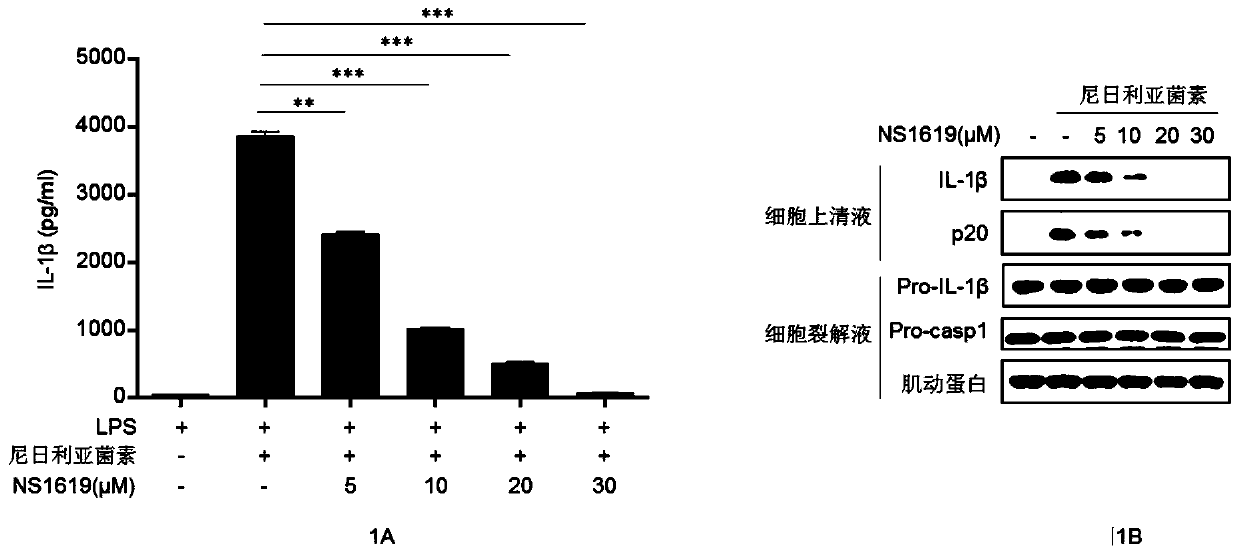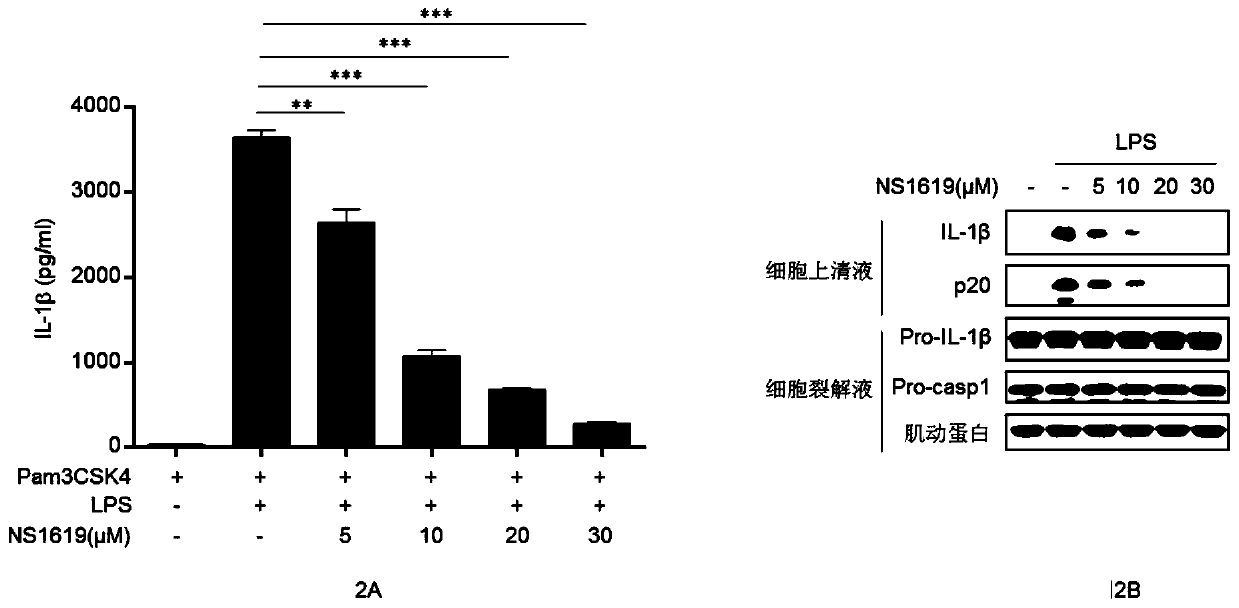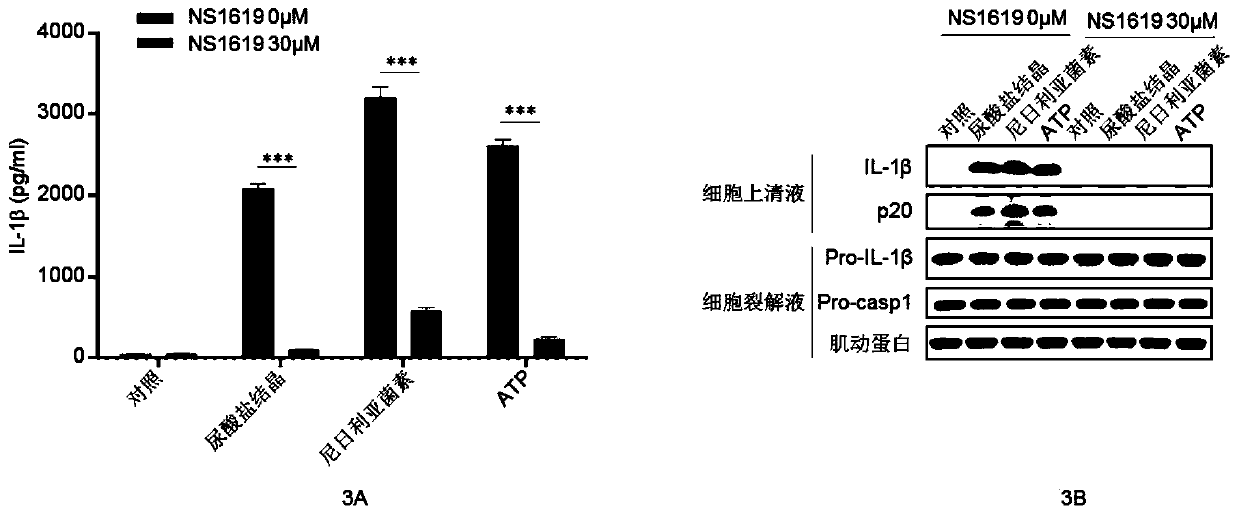Application of NS1619 for inhibiting activation of NLRP3 inflammatory corpuscles
A technology for inflammasomes and inflammatory diseases, applied in the directions of anti-inflammatory agents, digestive system, organic active ingredients, etc., can solve problems such as undiscovered functions, and achieve the effects of inhibiting maturation and secretion, inhibiting cell pyroptosis, and reducing peritonitis.
- Summary
- Abstract
- Description
- Claims
- Application Information
AI Technical Summary
Problems solved by technology
Method used
Image
Examples
Embodiment 1
[0072] Example 1 NS1619 specifically inhibits the activation of NLRP3 inflammasome in vitro
[0073] (1) Acquisition and differentiation of mouse bone marrow-derived macrophages (BMDM): take the bone marrow of C57BL / 6 mice about 8 weeks old, and use DMEM medium + 10% fetal bovine serum + 25ng / ml MSCF (macrophage) Phage-colony-stimulating molecule) differentiated for 4-5 days.
[0074] (2) Divide the differentiated BMDM cells into 12-well plates, 5*10^ 5 cells. The next day, the cells were pretreated with opti-MEM medium + 1% fetal calf serum + 50ng / ml LPS for 3-6 hours. Then, different concentrations of NS1619 (0 μM, 5 μM, 10 μM, 20 μM, 30 μM) were added for half an hour, and the cells were stimulated with 3.5 μM nigericin for 15 minutes, and then the cell supernatant and cell lysate were collected. At the same time, the pretreated cells were selected, and the cell supernatant and cell lysate were directly collected as a control. ELISA detects the secretion of IL-1β, and t...
Embodiment 2
[0082] Example 2 NS1619 does not affect the activation of AIM2 inflammasome and IPAF inflammasome
[0083] (1) Acquisition and differentiation of mouse bone marrow-derived macrophages: same as Example 1(1).
[0084] (2) Divide the differentiated BMDM cells into 12-well plates, 5*10^ 5 cells. The next day, pretreat the cells with opti-MEM medium + 1% fetal bovine serum + 50ng / ml LPS for 3-6 hours, divide the pretreated cells into six groups, first, divide them into two groups and add different concentrations NS1619 (0 μM, 30 μM) was treated for half an hour, and then each large group was divided into three groups, and the cells were stimulated with 700 μg / ml NLRP3 inflammasome agonist urate crystals (MSU) for 4 hours and 1 μg AIM2 inflammasome The agonist Poly(dA:dT) stimulated the cells for 2 hours and the non-stimulation group was used as a control, and the cell supernatant and cell lysate were collected. ELISA detects the secretion of IL-1β, and the results are as follows...
Embodiment 3
[0089] Example 3 NS1619 does not affect the activation of LPS-induced NF-κB signaling pathway in the preparation phase of NLRP3 inflammasome activation
[0090] (1) Acquisition and differentiation of mouse bone marrow-derived macrophages: same as Example 1(1).
[0091] (2) Divide the differentiated BMDM cells into 12-well plates, 5*10^ 5 cells. The next day, the cells were treated with opti-MEM medium+1% fetal bovine serum+50ng / ml LPS for 3-6 hours, and different concentrations of NS1619 (0μM, 5μM, 10μM, 20μM, 30 μM) for half an hour, and then stimulate the cells with 3.5 μM nigericin (Nigericin) for 15 minutes, then collect the cell supernatant and cell lysate. At the same time, the pretreated cells were selected, and the cell supernatant and cell lysate were directly collected as a control. ELISA detects the secretion of IL-6 and TNF-α, the results are as follows Figure 6 Shown in A and 6B; Western blot detection of NLRP3 inflammasome key protein NLRP3, pro-caspase-1, p...
PUM
 Login to View More
Login to View More Abstract
Description
Claims
Application Information
 Login to View More
Login to View More - R&D
- Intellectual Property
- Life Sciences
- Materials
- Tech Scout
- Unparalleled Data Quality
- Higher Quality Content
- 60% Fewer Hallucinations
Browse by: Latest US Patents, China's latest patents, Technical Efficacy Thesaurus, Application Domain, Technology Topic, Popular Technical Reports.
© 2025 PatSnap. All rights reserved.Legal|Privacy policy|Modern Slavery Act Transparency Statement|Sitemap|About US| Contact US: help@patsnap.com



